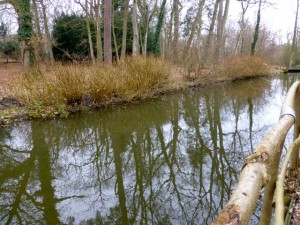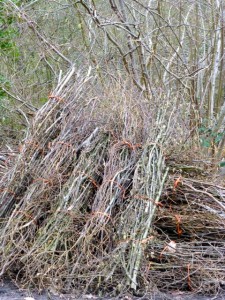Yesterday was spent in Waterworld. Driving along levees beside which marched rows of willows ripe for the pollard. Past mills and dykes and marshes and boatyards. On the ordnance survey the language is uber aqueous: Commissioners Dyke, Turf Fen and Swim Coots.

Reach for a map and see between Norwich and Caistor on Sea a patchwork of water lines and sluices. Embedded in these are a series of tidal lakes created by hand cutting of peat. This was done centuries ago to provide turves to fuel industry. The sea water has trickled into the pits to make a necklace of waterways and marshland.
This watery place is called the Norfolk Broads - a pretty famous destination for a boating holiday. Norfolk fills up the rounded swell of England, due north of London. The coastland swirls round the corner into the Wash - the bit that looks as if a giant dog has helped itself to a bite. And below this and to the East you will find loads of broads - Hickling, Barton and South Walsham amongst others. All begirt with reed beds and home to that seriously shy bird, the bittern.

The morning was spent with Louise, manager of Fairhaven Gardens. Fairhaven is a Trust and its garden is wrapped round the south shore of the South Walsham Broad. I learnt a little of how fine a balance there is to keeping a broad alive. If that sounds a bit peculiar, just let me tell you that the water has to be kept moving; stretches of water cannot be allowed to silt up. Left alone, water will become eutrophic and over-rich with nitrogen. A silted dyke will soon lead to flood waters spilling out into the marshes and beyond.
And so the winter months at Fairhaven are spent in hand clearing the 4 mile stretches of ditches and channels. Trees, particularly alders, drop leaf litter, or limbs and the succession or colonisation of water by organic mass begins. The intervention of man is vital. What the Trust is doing, along with a goodly list of other important things, is to keep the balance between man and nature. I love that symbiosis.
 Reach for a map and see between Norwich and Caistor on Sea a patchwork of water lines and sluices. Embedded in these are a series of tidal lakes created by hand cutting of peat. This was done centuries ago to provide turves to fuel industry. The sea water has trickled into the pits to make a necklace of waterways and marshland.
This watery place is called the Norfolk Broads - a pretty famous destination for a boating holiday. Norfolk fills up the rounded swell of England, due north of London. The coastland swirls round the corner into the Wash - the bit that looks as if a giant dog has helped itself to a bite. And below this and to the East you will find loads of broads - Hickling, Barton and South Walsham amongst others. All begirt with reed beds and home to that seriously shy bird, the bittern.
Reach for a map and see between Norwich and Caistor on Sea a patchwork of water lines and sluices. Embedded in these are a series of tidal lakes created by hand cutting of peat. This was done centuries ago to provide turves to fuel industry. The sea water has trickled into the pits to make a necklace of waterways and marshland.
This watery place is called the Norfolk Broads - a pretty famous destination for a boating holiday. Norfolk fills up the rounded swell of England, due north of London. The coastland swirls round the corner into the Wash - the bit that looks as if a giant dog has helped itself to a bite. And below this and to the East you will find loads of broads - Hickling, Barton and South Walsham amongst others. All begirt with reed beds and home to that seriously shy bird, the bittern.
 The morning was spent with Louise, manager of Fairhaven Gardens. Fairhaven is a Trust and its garden is wrapped round the south shore of the South Walsham Broad. I learnt a little of how fine a balance there is to keeping a broad alive. If that sounds a bit peculiar, just let me tell you that the water has to be kept moving; stretches of water cannot be allowed to silt up. Left alone, water will become eutrophic and over-rich with nitrogen. A silted dyke will soon lead to flood waters spilling out into the marshes and beyond.
And so the winter months at Fairhaven are spent in hand clearing the 4 mile stretches of ditches and channels. Trees, particularly alders, drop leaf litter, or limbs and the succession or colonisation of water by organic mass begins. The intervention of man is vital. What the Trust is doing, along with a goodly list of other important things, is to keep the balance between man and nature. I love that symbiosis.
The morning was spent with Louise, manager of Fairhaven Gardens. Fairhaven is a Trust and its garden is wrapped round the south shore of the South Walsham Broad. I learnt a little of how fine a balance there is to keeping a broad alive. If that sounds a bit peculiar, just let me tell you that the water has to be kept moving; stretches of water cannot be allowed to silt up. Left alone, water will become eutrophic and over-rich with nitrogen. A silted dyke will soon lead to flood waters spilling out into the marshes and beyond.
And so the winter months at Fairhaven are spent in hand clearing the 4 mile stretches of ditches and channels. Trees, particularly alders, drop leaf litter, or limbs and the succession or colonisation of water by organic mass begins. The intervention of man is vital. What the Trust is doing, along with a goodly list of other important things, is to keep the balance between man and nature. I love that symbiosis. 